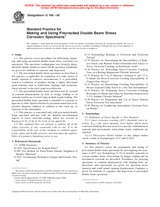We need your consent to use the individual data so that you can see information about your interests, among other things. Click "OK" to give your consent.
ASTM G168-00
Standard Practice for Making and Using Precracked Double Beam Stress Corrosion Specimens
STANDARD published on 10.5.2000
The information about the standard:
Designation standards: ASTM G168-00
Note: WITHDRAWN
Publication date standards: 10.5.2000
SKU: NS-57505
The number of pages: 10
Approximate weight : 30 g (0.07 lbs)
Country: American technical standard
Category: Technical standards ASTM
Annotation of standard text ASTM G168-00 :
Keywords:
rack growth rate, double cantilever beam specimen, KISCC, plateau velocity, precracked double beam specimen, precracked specimens, stress corrosion cracking, threshold stress intensity, ICS Number Code 77.060 (Corrosion of metals)
Additional information
| 1. Scope | ||||||||||||||||||||||
|
1.1 This practice covers procedures for fabricating, preparing, and using precracked double beam stress corrosion test specimens. This specimen configuration was formerly designated the double cantilever beam (DCB) specimen. Guidelines are given for methods of exposure and inspection. 1.2 The precracked double beam specimen, as described in this practice, is applicable for evaluation of a wide variety of metals exposed to corrosive environments. It is particularly suited to evaluation of products having a highly directional grain structure, such as rolled plate, forgings, and extrusions, when stressed in the short transverse direction. 1.3 The precracked double beam specimen may be stressed in constant displacement by bolt or wedge loading or in constant load by use of proof rings or dead weight loading. The precracked double beam specimen is amenable to exposure to aqueous or other liquid solutions by specimen immersion or by periodic dropwise addition of solution to the crack tip, or exposure to the atmosphere. 1.4 This practice is concerned only with precracked double beam specimen and not with the detailed environmental aspects of stress corrosion testing, which are covered in Practices G35, G36, G37, G41, G44, and G50. 1.5 This standard does not purport to address all of the safety concerns, if any, associated with its use. It is the responsibility of the user of this standard to establish appropriate safety and health practices and determine the applicability of regulatory limitations prior to use. |
||||||||||||||||||||||
| 2. Referenced Documents | ||||||||||||||||||||||
|
We recommend:
Technical standards updating
Do you want to make sure you use only the valid technical standards?
We can offer you a solution which will provide you a monthly overview concerning the updating of standards which you use.
Would you like to know more? Look at this page.




 Cookies
Cookies
